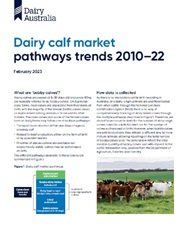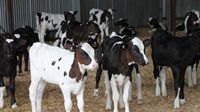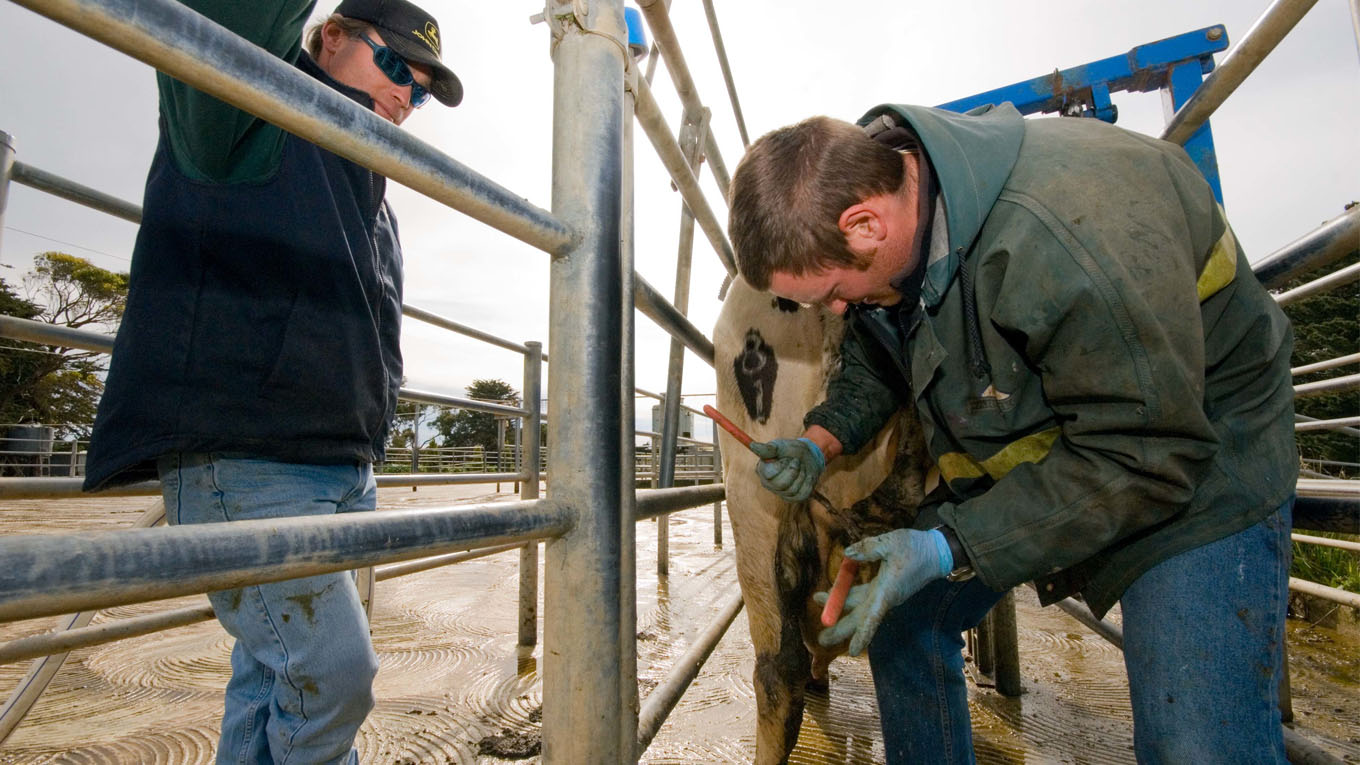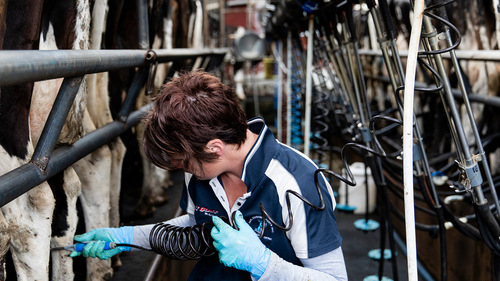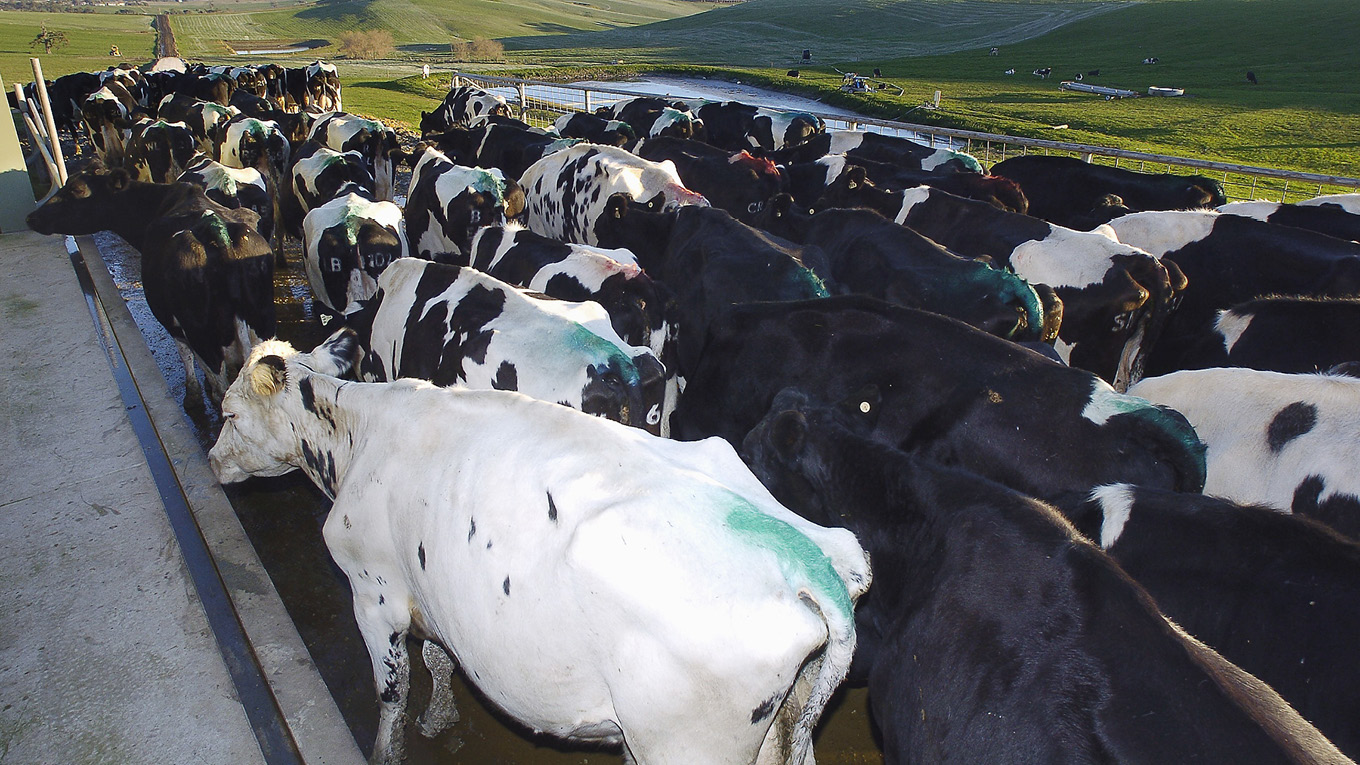Surplus Calves
The Australian dairy industry supports the development of socially acceptable and economically viable pathways for surplus calves. It is also working to ensure that everyone involved in the management, transportation, handling and marketing of calves understands their responsibilities for calf health and welfare, meets agreed standards and aims for continuous improvement.
Of all the calves born to the dairy herd each year, only a certain percentage (often only 20-30%) are required as replacement milking females. The rest of the calves born each year, being males and surplus females, are often referred to as ‘surplus’ or ‘non-replacement’ calves.
Traditionally, many surplus calves have been managed via early life slaughter either in the form of at-birth euthanasia or processing them through abattoirs as bobby calves (5-30 days old).
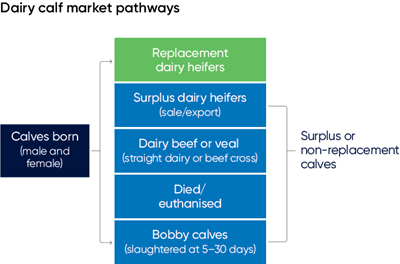
-
Sustainable management of surplus calves
Decisions about which pathways surplus or non-replacement calves are to be directed through have traditionally been made largely according to economic drivers. Historically, dairy breed animals have often been regarded as poor candidates for beef production, leading to price discounts. As a result, surplus calves have been more likely to be reared for beef production when beef prices are favourable, and more likely to be managed through early life slaughter when beef prices are poor (see Dairy Calf Market Pathway Trends 2010-21 fact sheet below).
Increasingly, the global dairy industry is recognising early life slaughter as a significant risk to the industry’s social license to operate, with many countries now moving to prevent the practice. Whilst this is not the case in Australia, it is increasingly being recognised that efforts should be made to work towards management practices for surplus calves that are more socially acceptable than early life slaughter in order to preserve our social license to operate.
The key challenge for the Australian dairy industry is to work towards alternatives to early life slaughter that are economically viable in addition to being socially acceptable. -
Responsible breeding strategies
Traditional approaches to breeding the dairy herd have focused on producing the required number of replacement females and maximising genetic gain. While this is still fundamentally important, the increasing focus on how we manage the surplus or non-replacement component of the calves born each year is seeing the emergence of what are sometimes referred to as ‘responsible breeding strategies’.
What is a ‘responsible breeding strategy’?
A ‘responsible breeding strategy’ places equal focus on the genetic merit of surplus calves and their intended purpose as it does the replacement heifer component of the calf drop. In this approach, consideration is given to all calves that are likely to be born, which cows they are to be bred from and the most appropriate sire for each calf’s intended pathway. Technologies that assist with these strategies include:
-
Sexed semen
-
Quality beef genetics (‘beef on dairy’ breeding programs)
-
Genomic selection
In practice, these strategies often involve using sexed semen and genomics to breed only the required number of replacement females from the highest genetic merit dams in the herd. Appropriate beef genetics can then be used as a terminal cross over lower genetic merit females from whom it is not desirable to breed the next generation of replacement females (also known as ‘beef on dairy’ breeding programs).
-
-
Alternatives to early life slaughter: Beef production
Whilst we know that rearing surplus calves for beef production is more socially acceptable than early life slaughter, ensuring the production systems are economically viable is a challenge.
Specific challenges to be met include:- Availability of labour
- Infrastructure to rear calves
- Potential impacts on animal welfare or the environment
- Potential fluctuations in seasonal conditions and commodity prices.
For a dairy farm business, the primary focus is of course on milk production, further complicating the challenge of achieving efficient beef production from the dairy herd.
-
Beef on dairy crossbreeding
When considering utilising a beef on dairy crossbreeding program, there are several important factors to keep in mind. These include what beef genetics to use, how the calves will be managed pre and post weaning, where the animals will be sold and market demand for these animals.
There are no one size fits all solutions when it comes to selecting the best beef breed for use over the dairy herd. There is a wide selection of sires to choose from and the decisions made can have a large impact on the success of the outcome. Some factors to consider include:
Impact on the dairy herd
- Fertility - when considering the cows in the herd that are likely to be bred to beef semen, it is likely that some of them may have had previous returns to service or been impacted by health issues such as dystocia. For this reason it is essential to prioritise fertility when selecting beef semen or bulls.
- Calving ease – with the primary focus of the dairy enterprise being milk production, minimising the incidence of dystocia is essential. An easy calving also helps calves get the best start possible. Beef sires can vary considerably in their Estimated Breeding Values for calving ease and this should always be prioritised when selecting sires.
- Gestation length – there are many beef bulls available for use over the dairy herd that have been selected for shorter gestation lengths. This can help later calving cows to calve earlier the following year which can be advantageous when using beef over the ‘tail end’ of the herd, especially in seasonal production systems.
Impact on the quality of calves
- Meat quality – in general, dairy breeds such as Holsteins and Jerseys rate quite highly in meat quality aspects such as taste, marbling and tenderness.
- Carcase conformation and yield – in contrast to quality, dairy breeds tend to underperform in carcase conformation and yield. Beef on dairy crossbreeding programs should therefore look to use sires that improve the carcase conformation and yield of crossbred calves while capitalising on the dairy breeds’ meat quality traits.
- Performance – whilst an emphasis on high calving ease and short gestation length are important factors when considering the impact on the dairy herd, it is important to ensure that this does not impact the growth and performance of the calf once it is born. Selecting for high growth rates in beef on dairy crossbred calves will help address the lower growth rates seen in pure dairy breed animals in comparison to beef breeds.
- Welfare – consider whether there are aspects of using a particular beef sire that can improve the welfare of the resultant calves. For example, using polled sires can help reduce the need for disbudding calves.
- Target market – where do you intend to sell the calves and what does the market desire of them? Is a particular coat colour or breed more desirable?
-
Rearing dairy beef calves
Breeding decisions that minimise impact on the dairy herd and maximise the calf’s potential for beef production is only the first step in achieving a successful beef on dairy program. From the moment a dairy beef calf hits the ground, attention to detail is vital to ensure they are set up for a productive life. The same important factors that apply to the management of replacement heifers can be applied to calves being reared for beef including:
-
Attention to hygiene
-
Effective colostrum management
-
Appropriate environment
-
Good nutrition
-
Appropriate husbandry procedures, including pain relief
-
Effective weaning
More information available on the Calf rearing webpage.
-
-
Understanding how the supply chain works together
Dairy beef supply chains can involve multiple different stakeholders including:
-
Genetics providers
-
Dairy farms
-
Calf rearers
-
Backgrounding operations
-
Feedlots
-
Meat processors
-
Retailers and/or food service
-
Customers
Understanding what each stakeholder in the supply chain needs and factoring this into decision making at each point is vital to the success of beef on dairy programs. Fluctuations in seasonal conditions and commodity prices will continue to challenge the viability of beef on dairy systems over the long term. However, ensuring we are breeding and growing calves that the market wants to buy will help to withstand some degree of market and seasonal volatility.
Consideration also needs to be given to how dairy-origin beef animals are being sold. There are a range of different options available for selling beef cattle, with some relying more on successful relationships along the supply chain than others. Things to consider include:-
Is it more desirable for the business to focus on the open market or elect to enter into forward price contracts?
-
How are we best placed to withstand year-on-year fluctuations in seasonal and commodity prices?
-
Could the method by which we sell animals and the markets to which we sell them impact the industry’s image and/or the welfare of the animals (e.g. selling via online market places to inexperienced landholders)?
Learn more about some of the different selling options available for beef animals.
-
-
Growing Beef from Dairy Conference
The Growing Beef from Dairy Conference was held on September 15, 2022 at Attwood, Melbourne where farmers, researchers, service providers and supply chain stakeholders convened for a full-day program of presentations dedicated entirely to beef production from the dairy herd.
This exciting hybrid event provided the opportunity to hear from local and international speakers on local and global policy and market updates, the latest research insights, beef on dairy breeding strategies, supply chain opportunities and more.
For those who were not able to make it, or for those who want to listen again, you can access the recordings. You can also view the conference program. -
Managing bobby calf welfare
Bobby calves are defined as calves less than 30 days of age, less than 80kg and transported without their mother.
All people responsible for the handling and transport of bobby calves – including farmers, calf buyers, agents, saleyards, transporters and meat processors – must follow the Australian Animal Welfare Standards for Land Transport of Livestock.
Developed in consultation with industry, animal welfare groups, governments and the public, the standards – which are incorporated in state legislation – require all those involved in the transportation of bobby calves to be responsible for the welfare of the animals under their care.
Everyone who handles calves must treat them with care and patience at all times and protect them from cold and heat. Calves must not be moved with dogs or electric prodders. Calves must also be fed within six hours before leaving the farm, must be delivered to their destination in less than 18 hours from their last feed and spend no more than 12 hours on transport or in transit. Bobby calves must also be slaughtered or fed within 30 hours from their last feed.
Farmers must ensure calves offered for sale are:
-
At least five days old (unless consigned direct to a calf rearer)
-
Fit and healthy (see Caring for bobby calf welfare before and during transport)\
-
Have been adequately fed within six hours of transport
Transporters must record when calves are picked up and ensure calves are:
-
Fit for the journey (see Caring for bobby calf welfare before and during transport)
-
Protected from cold and heat (see Transporting calves in crates or trailers fact sheet)
-
Handled appropriately during loading and unloading
-
Transported for the minimum time possible with no more than 12 hours spent on transport.
Saleyard operators, buyers, agents and processors must ensure calves are:
-
Handled appropriately
-
Protected from cold and heat,
-
Given access to water
-
Taken care of in cases of delay or emergency.
-
Related documents
-
Grain free calf trial fact sheet
PDF, 1.13 MB -
Caring for bobby calf welfare before and during transport
PDF, 1000.34 KB -
Bobby calf fit for transport factsheet
PDF, 271.36 KB -
Humane killing and disposal of sick or injured cattle
PDF, 554 KB -
Is the animal fit to load factsheet
PDF, 4.21 MB -
Johnes Disease Dairy Beef factsheet
PDF, 380.51 KB -
Transporting bobby calves factsheet
PDF, 410.74 KB
Bobby calf transport standards and guidelines
Bobby calves for sale sign
It is a legal requirement for farmers to clearly communicate to transporters that bobby calves offered for sale are fit for transport.
To help with this process, Dairy Australia has developed a sign for the calf pen.
To use this sign, fill in the time the calves were last fed and the latest time for pick-up (within six hours of last feeding).
Provide your phone number in case the calf buyer needs to contact you.
To order a free Bobby Calves for sale sign please contact us via email or a call.
The Growing Beef from Dairy Project
The Growing Beef from Dairy (GBfD) project aims to increase the adoption of economically sustainable dairy beef production as an alternative to early life slaughter of surplus calves through the adoption of best practice breeding and feeding for identified markets. Positioned over 5 years, the project is jointly funded 50:50 by Meat and Livestock Australia (MLA) and Dairy Australia (DA) levy funds and is being developed by AgSTAR Projects team of extension professionals.
New extension package
The project will develop a bespoke extension and adoption package to assist farmers to make better informed decisions on the management of surplus calves with a focus on the target market for the calves. The package will include modules that align to the age and target weight of the calves and will cover all components from breeding and genetics to nutrition, animal husbandry, animal health, welfare, biosecurity, transport, housing, markets and meat quality.
The team will use the latest extension methodologies and technologies to create adoption pathways suited to a range of producers, their advisors and supply chain stakeholders including the development of Train the Trainer and Advisor Short Course resources.
Facilitating supply chain collaboration
The project will also include Producer Demonstration Sites (PDS) which will bring together a group of farmers and supply chain stakeholders in a local region for facilitated discussion and field days over a two-year period. The PDS model aims to demonstrate different surplus calf market pathways, facilitate peer to peer learning amongst producers, improve connectedness along supply chains and ensure the extension resources developed during the project are relevant and meet the needs of all stakeholders. This model will initially be piloted in one region and commercial co-investment will be sought to implement additional PDSs in other regions beyond the pilot.
Throughout the project, the AgSTAR team will aim to consult and collaborate with dairy and beef producers, supply chain stakeholders, consultants, technical advisors and relevant industry organisations to ensure awareness, acceptance and adoption of the project outcomes.
Getting involved
Register your details if you would like to contribute or stay up to date with the Growing Beef from Dairy Project.
